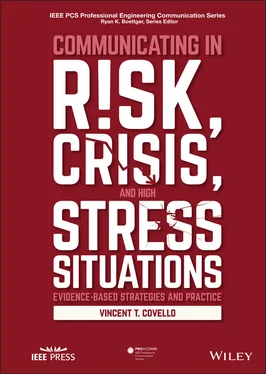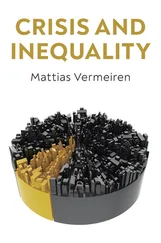38 Covello, V., Peters, R., Wojtecki, J., and Hyde, R. (2001). “Risk communication, the West Nile virus epidemic, and bio‐terrorism: Responding to the communication challenges posed by the intentional or unintentional release of a pathogen in an urban setting.” Journal of Urban Health 78(2):382–391.
39 Covello, V., Sandman, P., and Slovic, P. (1988). Risk Communication, Risk Statistics, and Risk Numbers. Washington, DC: CMA.
40 Covello, V., and Sandman, P. (2001). “Risk communication: Evolution and revolution,” in Solutions to an Environment in Peril, ed. A. Wolbarst. Baltimore, MD: Johns Hopkins University Press.
41 Covello, V., Slovic, P., and von Winterfeldt, D. (1986). “Risk communication: A review of the literature.” Risk Abstracts 3(4):171–182.
42 Covello, V., Minamyer, S., and Clayton, K. (2007). Effective Risk and Crisis Communication during Water Security Emergencies . EPA Policy Report; EPA 600‐R07‐027. Washington, D.C.: U.S. Environmental Protection Agency.
43 Covello, V., and Sandman, P.M., (2001). Risk communication: Evolution and revolution, in Solutions to an environment in peril, ed. A. Wolbarst (Ed.; in press). Baltimore, MD: John Hopkins University Press: 166–178.
44 Covello, V., Slovic, P., and von Winterfeld, D. (1987). Risk Communication: A Review of the Literature. Washington, DC: National Science Foundation.
45 Cox Jr., A.L. (2012). “Confronting deep uncertainties in risk analysis.” Risk Analysis 32 (10):1607–1629.
46 Cvetkovich, G., Siegrist, M., Murray R., and Tragesser, S. (2002). “New information and social trust asymmetry and perseverance of attributions about hazard managers.” Risk Analysis 22(2):359–367.
47 Dietz, T. (2013). “Bringing values and deliberation to science communication.” Proceedings of the National Academy of Sciences 110:14081–14087.
48 Dunwoody, S. (2014). “Science journalism,” in Handbook of Public Communication of Science and Technology, eds. M. Bucchi and B. Trench. New York: Routledge.
49 Earle, T.C. (2010). “Trust in risk management: A model‐based review of empirical research.” Risk Analysis 30(4):541–574.
50 Earle, T.C., and Siegrist, M. (2008). “On the relation between trust and fairness in environmental risk management.” Risk Analysis 28(5):1395–1414.
51 Federal Emergency Management Agency (2021). FEMA Flood Risk Communication Toolkit for Community Officials. Washington, DC: Federal Emergency Management Agency.
52 Fearn‐Banks, K. (2007). Crisis Communications: A Casebook Approach, 3rd ed. Mahwah, NJ: Lawrence Erlbaum Associates.
53 Fischhoff, B. (1989). “Helping the public make health risk decisions. In Effective Risk Communication: The Role and Responsibility of Government and Nongovernment Organizations”, eds. Covello, V., McCallum, D.B., Pavlova, M.T. New York, NY: Plenum Press: 111–116.
54 Fischhoff, B., Slovic, P., Lichtenstein, L., Read, S., and Combs, B. (1978). “How safe is safe enough? A psychometric study of attitudes towards technological risks and benefits.” Policy Sciences 9:127–152.
55 Fischhoff, B. (1995a). “Risk perception and communication unplugged: twenty years of process.” Risk Analysis 15(2):137–145.
56 Fischhoff, B. (1995b). “Strategies for risk communication. Appendix C.” in National Research Council: Improving Risk Communication. Washington, DC: National Academies Press.
57 Fischhoff, B. (2012). Judgment and Decision Making. New York: Earthscan.
58 Fischhoff, B. (2013). “The Sciences of Science Communication,” in Proceedings of the National Academy of Sciences 110 (Supplement 3):14033–14039.
59 Fischhoff, B., Brewer, N.T., and Downs, J.S., eds. (2011). Communicating Risks and Benefits: An Evidence‐based User’s Guide. Washington, DC: Food and Drug Administration.
60 Fischhoff, B., and Davis, A.L. (2014). “Communicating scientific uncertainty,” in Proceedings of the National Academy of Sciences of the United States of America 111 (Suppl. 4): 13664–13671.
61 Fischhoff, B., and Kadvany, J. (2011). Risk: A Very Short Introduction. New York: Oxford University Press.
62 Fischhoff, B., Lichtenstein, S., Slovic, P., and Keeney, D. (1981). Acceptable Risk. Cambridge, MA: Cambridge University Press.
63 Flynn, J., Slovic, P., and Mertz, C.K. (1994). “Gender, race, and perception of environmental health risks.” Risk Analysis 14(6):1101–1108.
64 Giddens, A. (1991). The Consequences of Modernity. Cambridge, UK: Polity Press.
65 Glik D.C. (2007). “Risk communication for public health emergencies.” Annual Review of Public Health 28(1):33–54.
66 Hance, B. J., Chess, C., and Sandman, P. M. (1990). Industry Risk Communication Manual. Boca Raton, FL: CRC Press/Lewis Publishers.
67 Halvorsen, P. A. (2010). “What information do patients need to make a medical decision?” Medical Decision Making 30 (5 Suppl):11S–13S.
68 Haight, J.M., ed. (2008). The Safety Professionals Handbook: Technical Applications. Des Plaines, IL: The American Society of Safety Engineers.
69 Heath, R., and O’Hair, D., eds. (2009). Handbook of Risk and Crisis Communication. New York: Routledge.
70 Hess, R., Visschers, V.H.M., Siegrist, M., and Keller, C. (2011). “How do people perceive graphical risk communication? The role of subjective numeracy.” Journal of Risk Research 14(1):47–61.
71 Hyer, R.N., and Covello, V.T. (2007). Effective Media Communication During Public Health Emergencies: A World Health Organization Handbook. Geneva: World Health Organization Publications.
72 Jardine, C.G., Driedger S.M. (2014). “Risk communication for empowerment: an ultimate or elusive goal?” in Effective Risk Communication, eds J. Arvai and L. Rivers III. London: Earthscan.
73 Hyer, R., and Covello, V. (2007). Effective Media Communication during Public Health Emergencies: A World Health Organization Handbook. Geneva, Switzerland: World Health Organization.
74 Johnson, B.B., and Covello, V. (1987). The Social and Cultural Construction of Risk: Essays on Risk Selection and Perception. Dordrecht, Holland: D.Reidel Publishing.
75 Joslyn, S., and LeClerc, J. (2012). “Uncertainty forecasts improve weather related decisions and attenuate the effects of forecast error.” Journal of Experimental Psychology 18:126–140.
76 Joslyn, S., Nadav‐Greenberg, L., Taing, M.U., and Nichols, R.M. (2009). “The effects of wording on the understanding and use of uncertainty information in a threshold forecasting decision.” Applied Cognitive Psychology 23:55–72.
77 Kahneman, D. (2011). Thinking, Fast and Slow. New York: Macmillan Publishers.
78 Kahneman, D., Slovic, P., and Tversky, A., eds. (1982). Judgment Under Uncertainty: Heuristics and Biases. New York: Cambridge University Press.
79 Kahneman, D. Tversky, A. (1979). “Prospect theory: An analysis of decision under risk.” Econometrica, 47(2):263–291.
80 Kasperson, R.E. (1986). “Six Propositions on public participation and their relevance for risk communication.” Risk Analysis 6(3):275–281.
81 Kasperson, R.E. (2014). “Four questions for risk communication.” Journal of Risk Research 17 (10):1233–1239.
82 Kasperson, R.E., Golding, D., and Tuler, S. (1992). “Social distrust as a factor in sitting hazardous facilities and communicating risks.” Journal of Social Issues 48(4):161–187.
83 Kasperson, R. E., Renn, O., Slovic, P., Brown, H.S., Emel, J., Goble, R., Kasperson, J. X., and Ratick, S. (1987). “Social amplification of risk: A conceptual framework.” Risk Analysis 8 (2):177–187.
84 Kasperson, R., Kasperson, J.X., and Golding, D. (1999). “Risk, Trust, and Democratic Theory,” in Social Trust and the Management of Risk, eds. G. Cvetkovich, R. Löfstedt. London: Earthscan.
Читать дальше












